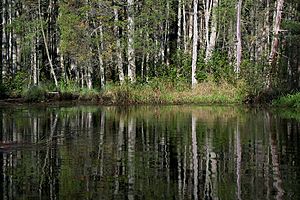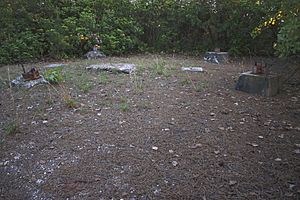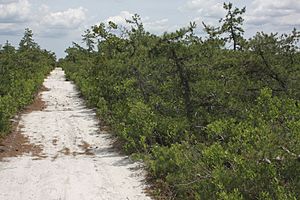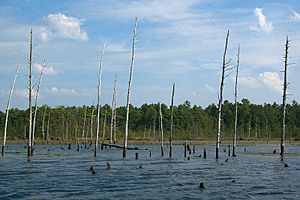Penn State Forest facts for kids
Quick facts for kids Penn State Forest |
|
|---|---|

Atlantic white cedars along the banks of the Oswego River
|
|
| Lua error in Module:Location_map at line 420: attempt to index field 'wikibase' (a nil value). | |
| Location | Burlington County, New Jersey |
| Nearest town | Jenkins Neck and Chatsworth |
| Area | 3,366 acres (5.259 sq mi) |
| Created | 1910 |
| Operated by | New Jersey Division of Parks and Forestry |
Penn State Forest is a large state park in Burlington County, New Jersey. It covers about 3,366 acres (5.259 sq mi). This forest is a special part of the Pine Barrens, an important natural area.
Visitors can enjoy many fun activities here. You can swim, boat, and fish in Oswego Lake and the Oswego River. The lake also has a picnic area, a boat launch, and restrooms.
The forest has many unpaved roads made of gravel, dirt, and sand. These roads are great for hiking, mountain biking, and horseback riding. In winter, you can even go cross-country skiing. Some roads are also open for four-wheel driving.
If you like wildlife, you might see deer, wild turkey, and water fowl. Hunting for these animals and other small game is allowed during certain times of the year. A very unique part of the park is the Pine Barren Plains, also called the Pygmy Forest. Here, trees only grow to about 4 ft (1.2 m) tall!
Penn State Forest is managed by the New Jersey Division of Parks and Forestry.
Contents
History of Penn State Forest
The first people to live in this area were the Lenape tribe of Native Americans. They left behind evidence like shell middens, which are piles of shells from the shellfish they ate.
European settlers built a small village called Penn Place in the 1800s. It was located along the Oswego River. The state of New Jersey bought this land in 1910 to create Penn Reserve, which later became Penn State Forest.
Building the Park
In 1933, the Civilian Conservation Corps (CCC) began working in the park. This group helped build many of the gravel roads you see today. The CCC workers at Penn State Forest were all African Americans, as work crews were separated during that time. Their camp was located northeast of Oswego Lake.
Plane Crash and Fire Towers
A wooden fire lookout tower was built on Bear Swamp Hill in 1915. This tower helped spot forest fires. After it burned down, a new, modern tower was built in 1960.
Sadly, this new tower was destroyed in 1971. A supersonic F-105 Thunderchief jet, flown by an Air National Guard pilot, crashed during a practice bombing run. The crash killed the pilot and destroyed about 1000 trees, creating a path of damage about 1 mi (1.6 km) long.
Protecting the Pine Barrens
From the 1950s to the 1970s, there were plans to build a huge airport in the Pine Barrens. This airport would have covered a large area, including parts of Penn State Forest. It even suggested filling in Oswego Lake to make a runway!
However, many people were worried about the environment. Because of these environmental concerns, the airport plans never happened. In 1978, the federal government created the New Jersey Pinelands National Reserve. This protected Penn State Forest and the rest of the Pine Barrens from future building projects.
The Pine Barren Plains: A Pygmy Forest
Penn State Forest is home to a very special area called the Pine Barren Plains. It's also known as the Pine Plains or the Pygmy Forest. This is a globally rare dwarf forest ecosystem. The trees here only grow to about 4 ft (1.2 m) tall, even when they are fully grown!
New Jersey has the largest area of this type of dwarf forest in the world. In Penn State Forest, you'll mostly see pitch pine and blackjack oak trees.
Scientists believe these trees stay short for several reasons:
- They face frequent droughts (very dry periods).
- The soil doesn't have many nutrients.
- The area has higher winds because of its elevation.
- There are more wildfires here than in other parts of the Pine Barrens.
Oswego Lake: Fun and Function
Oswego Lake is a 90-acre (0.14 sq mi) artificial lake. It was created in 1942 by building a dam on the Oswego River. This lake is a great spot for swimming, boating, and fishing.
The lake also serves an important purpose: it acts as a reservoir for cranberry farms downstream. The water from the lake helps these farms grow cranberries.
You can explore the upper parts of the Oswego River by canoe or kayak. If you're adventurous, you can even paddle south out of the park to Harrisville Lake. You'll just need to carry your boat around the dam.




